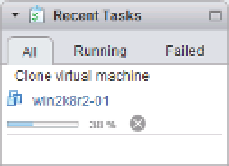Information Technology Reference
In-Depth Information
12.
Click Finish to complete the guest customization process and return to the Clone Existing
Virtual Machine Wizard, select the newly created specii cation and then click Next.
13.
Review the settings for cloning the VM. If any of the settings are incorrect, use the Back
button or the hyperlinks on the left to go back to the appropriate section and make any
desired changes. Otherwise, click Finish to start the VM cloning process.
When the VM cloning process kicks off, the vSphere Web Client will show a new active task
in the Recent Tasks area, as shown in Figure 10.8. From here, you can monitor the progress of the
cloning operation.
Figure 10.8
h e cloning task in
the vSphere Web
Client provides
feedback on the
current status of
the VM cloning
operation.
Once the cloning is complete, you can power on the VM. Note that the guest OS customiza-
tion won't begin until you power on the VM. After you power on the VM and the guest OS
loads, the vSphere Web Client will kick in and start the guest customization process. Depending
on the guest OS, it may take at least one reboot before the customization process is complete.
Cloning Running VMs
It's possible to clone even powered-on VMs! h e context menu of a VM provides a Clone option that
allows you to make a copy of the VM. h e Clone To New Virtual Machine option from the Commands
list on a VM summary page accomplishes the same task. h ese commands are available for VMs
that are powered off as well as VMs that are powered on. Keep in mind that unless you customize
the guest OS, an exact copy of the original VM will be made. h is could be especially useful when
you're looking to create a test environment that mirrors a live production environment.
As you can see, cloning VMs—which may take only a few minutes, depending upon the size
of the VM and your infrastructure—is a much faster way of deploying new VMs than manually
creating the VM and installing the guest OS.
Through VM cloning, administrators can create a library of “gold VM images,” master cop-
ies of VMs that have certain settings and a particular guest OS installed. The only problem
with this approach is that these VMs, which are intended to serve as master copies and not
be changed, can still be powered on and modii ed. This potential shortcoming is addressed
































